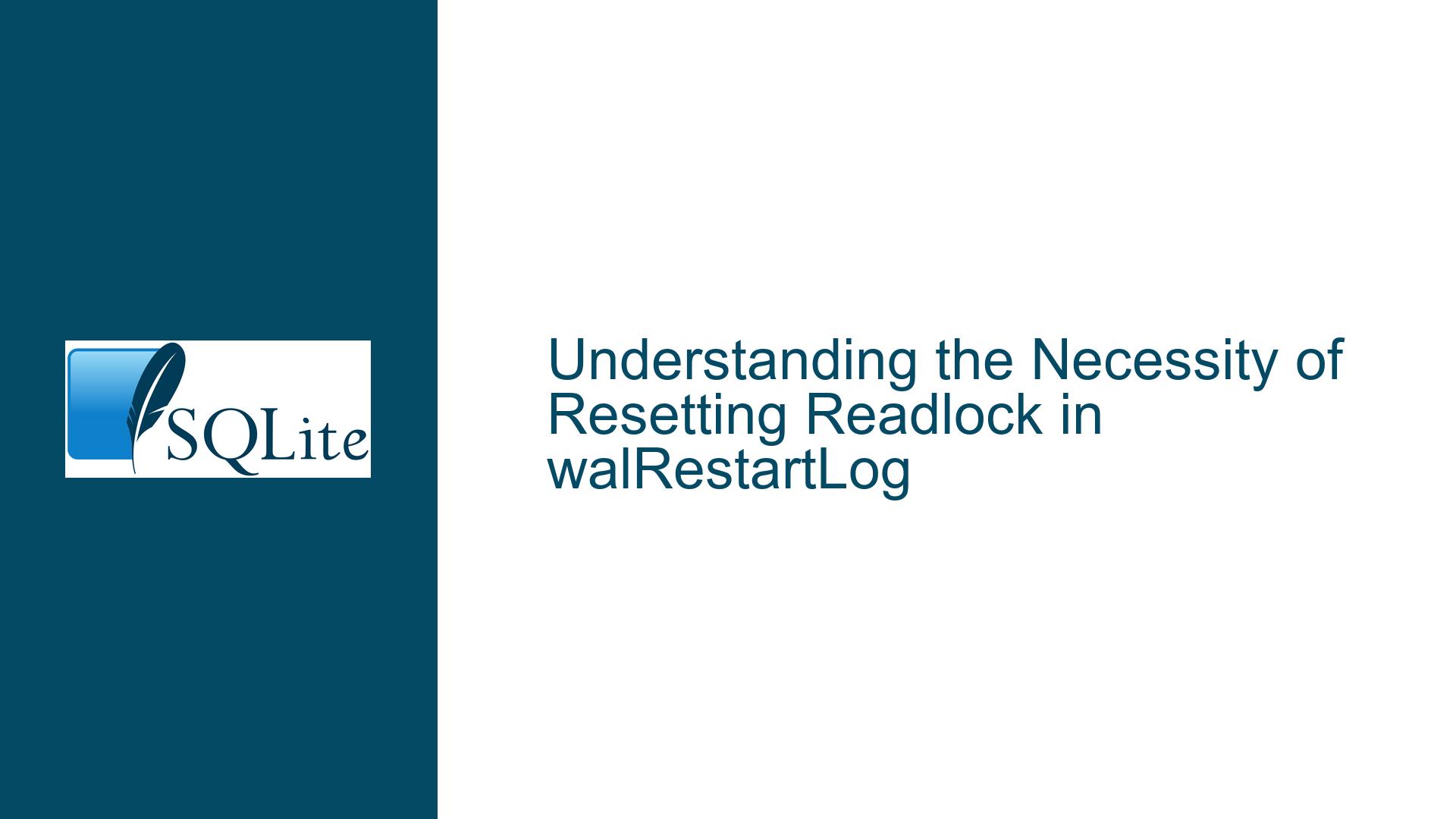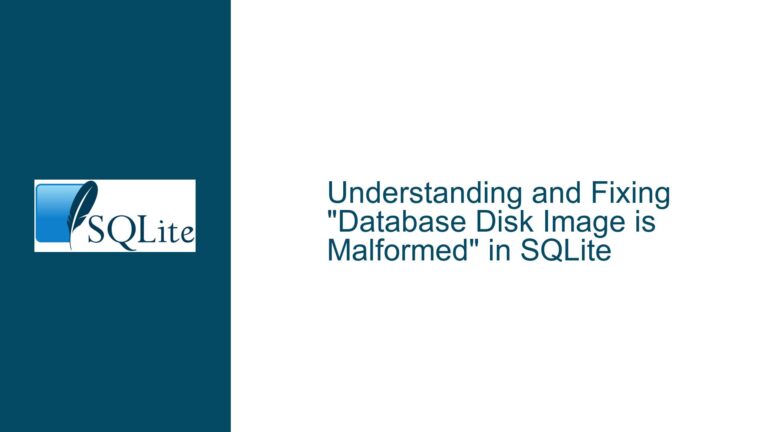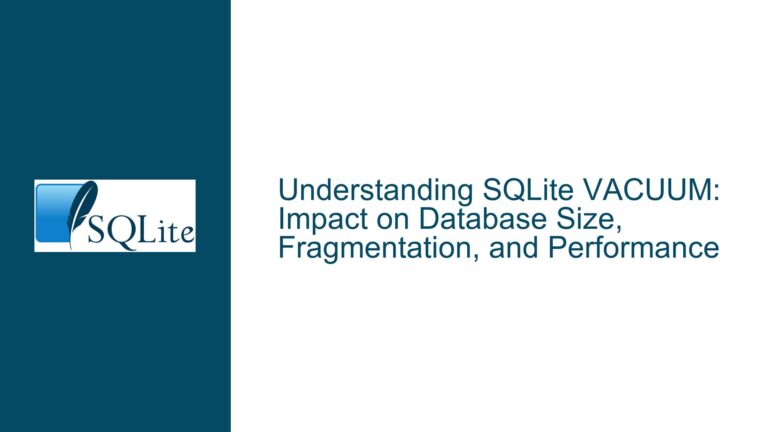the Necessity of Resetting Readlock in walRestartLog
Issue Overview: The Role of Readlock Reset in walRestartLog
In SQLite’s Write-Ahead Logging (WAL) mode, the walRestartLog function plays a critical role in managing the synchronization between read and write transactions. The core issue revolves around the necessity of resetting the readlock to a value greater than 0 after the walRestartHdr function is called. This reset operation is not immediately intuitive, and its purpose has been a point of contention and confusion among developers.
The walRestartLog function is invoked during the process of restarting the WAL log, which occurs when the log file reaches a certain size or when a checkpoint operation is performed. The function’s primary responsibility is to ensure that the WAL log is in a consistent state before any new write transactions are allowed to proceed. One of the key steps in this process is the resetting of the readlock, which is a mechanism used to manage concurrent access to the database.
The readlock is a crucial component of SQLite’s concurrency control mechanism. It ensures that multiple readers can access the database simultaneously without interfering with each other or with writers. When a read transaction is initiated, a readlock is acquired, and it is released when the transaction is completed. However, in the context of walRestartLog, the readlock is reset to a non-zero value even after the walRestartHdr function has been called. This behavior has led to questions about whether this reset operation is strictly necessary or if it is merely a performance optimization.
The confusion arises from the fact that the write lock in WAL mode is exclusive, meaning that only one writer can hold the lock at any given time. Given this exclusivity, it might seem redundant to reset the readlock since the writer holding the write lock can detect whether a restart is needed. However, as the discussion reveals, there are subtle nuances in the interaction between read and write transactions that necessitate this reset operation.
Possible Causes: Why Resetting Readlock is Essential
The necessity of resetting the readlock in walRestartLog can be attributed to several factors related to SQLite’s concurrency control and transaction management. One of the primary reasons is the need to maintain snapshot isolation, which is a fundamental property of SQLite’s WAL mode. Snapshot isolation ensures that each transaction sees a consistent view of the database, even if other transactions are modifying the data concurrently.
When a write transaction is committed, but there are still active read transactions (e.g., unfinalized SELECT statements), the read transaction must continue to hold a readlock other than 0. This is because, if the readlock were to be released, a second writer could potentially write a new transaction to the WAL file, and a checkpointer could run before the read transaction finishes. This sequence of events would break snapshot isolation, as the read transaction would no longer see a consistent view of the database.
The resetting of the readlock in walRestartLog ensures that the read transaction continues to hold a valid readlock even after the write transaction has been committed. This prevents the scenario where a second writer could interfere with the ongoing read transaction, thereby preserving snapshot isolation.
Another important consideration is the behavior of passive checkpoints. Unlike active checkpoints, which require a write lock, passive checkpoints can proceed without acquiring the write lock. This means that a passive checkpoint could potentially run concurrently with an active read transaction. If the readlock were not reset, the passive checkpoint could interfere with the read transaction, leading to inconsistencies in the database.
Furthermore, the resetting of the readlock is also related to the order in which locks are acquired and released in SQLite’s WAL mode. When a transaction begins, the read lock is acquired first, followed by the write lock if the transaction involves any modifications to the database. The locks are released in the reverse order when the transaction is committed. However, if there are still active read transactions when the write transaction is committed, the read lock is not released immediately. Instead, it is held until all read transactions are completed. This ensures that the read transactions continue to see a consistent view of the database, even if new write transactions are being committed.
Troubleshooting Steps, Solutions & Fixes: Ensuring Proper Readlock Management
To ensure proper management of the readlock in walRestartLog, it is essential to understand the sequence of operations that occur during the restart of the WAL log and the implications of resetting the readlock. The following steps outline the key considerations and potential solutions for addressing the issues related to readlock resetting:
Understanding the Locking Mechanism: The first step in troubleshooting the
readlockreset issue is to gain a deep understanding of SQLite’s locking mechanism in WAL mode. This includes understanding the roles of the read lock, write lock, and checkpoint lock, as well as the order in which these locks are acquired and released. It is also important to understand the concept of snapshot isolation and how it is maintained in the presence of concurrent read and write transactions.Analyzing the walRestartLog Function: The next step is to analyze the
walRestartLogfunction in detail, paying particular attention to the sequence of operations that occur during the restart of the WAL log. This includes understanding the role of thewalRestartHdrfunction, which is responsible for resetting the WAL header, and the subsequent resetting of thereadlock. It is important to understand why thereadlockis reset to a non-zero value and how this operation contributes to maintaining snapshot isolation.Examining the Interaction Between Read and Write Transactions: Another critical step is to examine the interaction between read and write transactions in SQLite’s WAL mode. This includes understanding how read transactions are managed when a write transaction is committed, particularly in cases where there are still active read transactions. It is important to understand why the
readlockis not released immediately when the write transaction is committed and how this affects the behavior of passive checkpoints.Testing and Validation: Once the underlying mechanisms have been understood, the next step is to conduct thorough testing and validation to ensure that the
readlockreset operation is functioning as intended. This includes testing scenarios where there are concurrent read and write transactions, as well as scenarios where passive checkpoints are running concurrently with active read transactions. The goal is to verify that snapshot isolation is maintained and that the database remains consistent in all scenarios.Optimizing Performance: While the primary goal of resetting the
readlockis to maintain consistency and snapshot isolation, it is also important to consider the performance implications of this operation. In some cases, the resetting of thereadlockmay introduce additional overhead, particularly in high-concurrency environments. It is important to evaluate whether the performance impact is acceptable and to explore potential optimizations if necessary.Reviewing the Code and Documentation: Finally, it is important to review the relevant code and documentation to ensure that the behavior of the
walRestartLogfunction is well-documented and understood by all developers working on the project. This includes documenting the rationale for resetting thereadlock, the potential impact on performance, and any known issues or limitations. It is also important to ensure that the code is well-commented and that any potential pitfalls or edge cases are clearly documented.
In conclusion, the resetting of the readlock in walRestartLog is a critical operation that plays a key role in maintaining snapshot isolation and ensuring the consistency of the database in SQLite’s WAL mode. While the necessity of this operation may not be immediately obvious, a thorough understanding of the underlying mechanisms and careful analysis of the interaction between read and write transactions reveals its importance. By following the troubleshooting steps outlined above, developers can ensure that the readlock is managed correctly and that the database remains consistent and performant in all scenarios.






